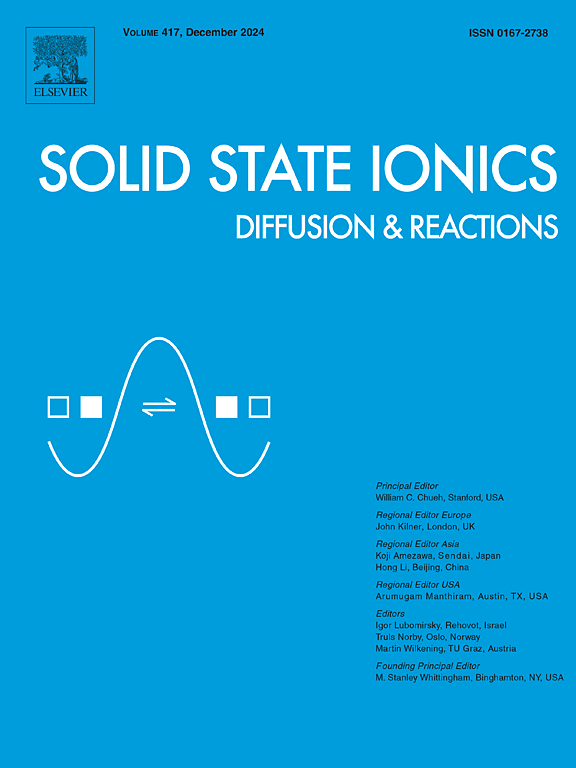钠β″-氧化铝中的Na+自扩散和离子输运
IF 3.3
4区 材料科学
Q3 CHEMISTRY, PHYSICAL
引用次数: 0
摘要
快速离子传输对于作为电解质的固体材料是至关重要的,只有少数类别达到实际使用所需的高离子电导率。Na β″-氧化铝中快速离子传输的发现不仅引入了一类开创性的材料,而且标志着现在被称为固态离子学的研究领域的出现。自20世纪80年代初以来,Na β″-氧化铝已被广泛认为是高温钠基电池(如钠硫电池)的固体电解质。尽管对层状结构Na β″-氧化铝的扩散和输运性质进行了大量的研究,但结合电导率和核磁共振(NMR)来研究近程和远程离子动力学的综合研究一直缺乏。在这项工作中,我们使用了一种市售的,高度烧结的Na β″-氧化铝样品,通过GHz电导率光谱和23Na核自旋弛豫来详细探索Na+动力学。这两种方法提供了相当一致的离子传输图像。在室温下,Na+的远程传输电导率为4 mS cm - 1,受0.3 eV的活化能控制,而短程运动感应到0.13 eV的势垒。如果用改进的BPP (Bloembergen, Purcell, Pound)谱密度函数分析,从特征电弛豫频率得到的Arrhenius预因子与从扩散诱导的纵向核磁共振自旋晶格弛豫率得到的结果一致。本文章由计算机程序翻译,如有差异,请以英文原文为准。

Na+ self-diffusion and ionic transport in sodium β″-alumina
Fast ion transport is crucial for solid materials to serve as electrolytes, with only a few classes achieving the high ionic conductivity needed for practical use. The discovery of fast ion transport in Na β″-alumina not only introduced a groundbreaking class of materials but also marked the advent of the research field now known as solid-state ionics. Since the early 1980s, Na β″-alumina has been widely recognized as a solid electrolyte for high-temperature sodium-based batteries, such as Na‑sulfur batteries. Despite numerous studies on the diffusion and transport properties of layer-structured Na β″-alumina, a comprehensive investigation combining conductivity and nuclear magnetic resonance (NMR) to study both short-range and long-range ion dynamics has been lacking. In this work, we used a commercially available, highly sintered Na β″-alumina sample to explore Na+ dynamics in detail through GHz conductivity spectroscopy and 23Na nuclear spin relaxation. The two methods provide a rather consistent picture of ion transport. While long-range Na+ transport, reaching a conductivity of 4 mS cm−1 at ambient temperature, is governed by an activation energy of 0.3 eV, short-range motions sense a barrier of 0.13 eV. The Arrhenius pre-factor obtained from characteristic electric relaxation frequencies is consist with that determined from diffusion-induced longitudinal NMR spin-lattice relaxation rates if analyzed with a modified BPP (Bloembergen, Purcell, Pound) spectral density function.
求助全文
通过发布文献求助,成功后即可免费获取论文全文。
去求助
来源期刊

Solid State Ionics
物理-物理:凝聚态物理
CiteScore
6.10
自引率
3.10%
发文量
152
审稿时长
58 days
期刊介绍:
This interdisciplinary journal is devoted to the physics, chemistry and materials science of diffusion, mass transport, and reactivity of solids. The major part of each issue is devoted to articles on:
(i) physics and chemistry of defects in solids;
(ii) reactions in and on solids, e.g. intercalation, corrosion, oxidation, sintering;
(iii) ion transport measurements, mechanisms and theory;
(iv) solid state electrochemistry;
(v) ionically-electronically mixed conducting solids.
Related technological applications are also included, provided their characteristics are interpreted in terms of the basic solid state properties.
Review papers and relevant symposium proceedings are welcome.
 求助内容:
求助内容: 应助结果提醒方式:
应助结果提醒方式:


